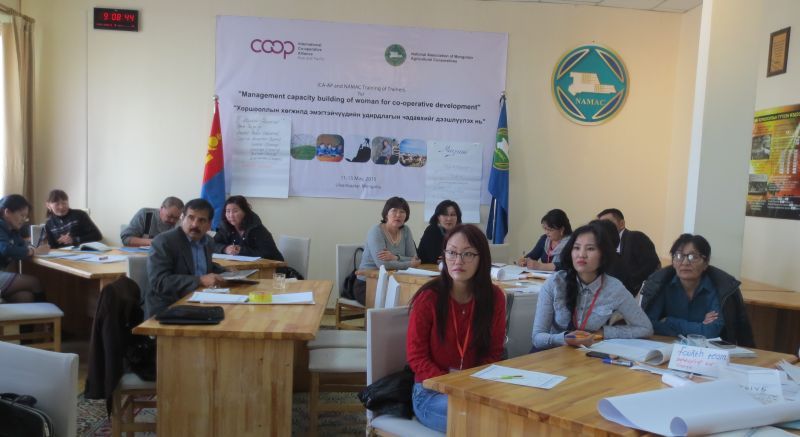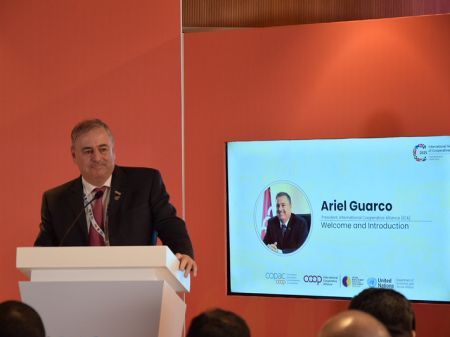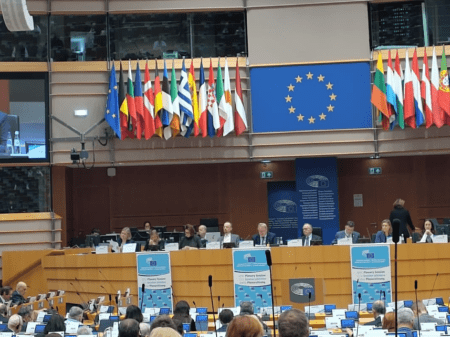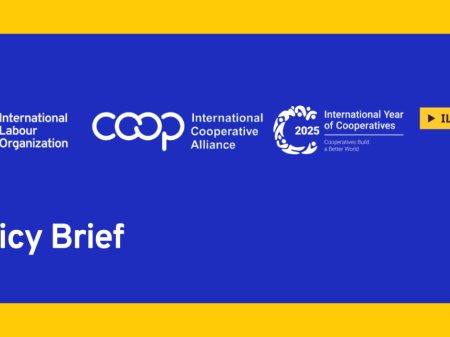
Mongolia ranks 42 among 142 countries in the Global Gender Gap Index 2014 published by the World Economic Forum. It fares much better in comparison to some of the more advanced countries like Japan and China. Mongolian women have been ranked high in economic participation, higher education and in health and survival. However, the notion of superiority of men persists despite the many indicators reflecting positive socio-economic and political environment for gender equality in Mongolia. This was evident in participation and in the group dynamics at the Training of Trainers (ToT), an event organised by the International Cooperative Alliance Asia and Pacific (ICA-AP) in association with the National Association of Agricultural Co-operatives of Mongolia (NAMAC). The training took place on 11-15 May in Ulaanbaatar City and focused on Management Capacity Building for Women in Co-operative Development.
Six out of the 26 participants from different provinces of Mongolia were men. The participants were divided into four groups, with the men assigned to separate groups. The groups were asked to elect a leader; the women in the group where a man was present automatically pointed to the man as leader. They said, “as a habit we defer leadership role to men. It will take time to change this.”
The training consisted of lectures, hands-on exercises, and field visits. The sessions were covered over four days: Gender perspective and projects in Mongolia by Ms Purevsuren Bolormaa, ILO, Mongolia; Status paper on Mongolian Co-operatives Business by Mr L Temuujin, Chief Executive Officer, NAMAC; Alliance Gender Initiative and Leadership Development of Women in Co-operatives – Global Perspective by Ms Savitri Singh; Leadership Skills and Personal Management and Financial Management for women leaders by Ms Daisybelle M Cabal, Education, Training and Consultancy Head, National Confederation of Cooperatives, Philippines; Monitoring and Evaluation of Cooperative Development Projects and Coop Identity and Management of Cooperative by Mr Balu Iyer; and Financial Management of Co-operatives by Ms M. Delgermaa, Expert in financial management of Mongolian Confederation of Credit Unions (MOCCU) and Ms G Uyanga, member of MOCCU Cooperation Sub Committee.
Participants also visited Uvur-orgioch Urban Area Co-operative near Ulaanbaatar City. This co-operative, led by an enterprising chairperson, Byambasuren, is running a successful dairy business. The 36 members (7 women and 29 men) collect milk from members and non-members; process it locally into yoghurt, cheese and ice-cream; brand their products (Masha); and sell them to consumers in UB. Byambasuren told the visiting group, “We started as an informal group in 2006 with World Vision support. When we wanted to formalise, we looked at different options and opted for a co-operative (in 2008) as members are owners and benefit directly. We have successful because we have focused on products that work (dropped poultry and piggery) and focused on value added products (processed milk rather than selling just milk).”
The co-operative started with nine members contributing MT 100,000 and a one time membership fee of MT 25,000. The turnover from dairy is MT 120m. In addition to dairy processing, the co-operative has a green house facility for vegetable production and imparts training on milk processing, vegetable gardening and handicraft making.
Mr Ganbold, director from the Darkhan Noos (Wool) Cooperative said, “the gender aspect has been an eye opener for me. I hope to go back and talk to my members and see how I can improve things.” Dungamaa from Selenge whose co-operative is involved in dairy said, “we were selling milk to a contractor who recently terminated the contract because of oversupply. If we were able to process as the group in Uvur Orgioch is doing, we would be in a much better position. This visit and training has been a learning experience.” Oyun, Head of Shireet Khugjil in Tuv province said, “In our co-operative women are very active. The training and visit provided input for me to expand marketing of our products.”
Management of Consumer Co-operatives
The 15th International Co-operative Alliance Asia-Pacific Regional Workshop on “Management of Consumer Co-operatives” was held by ICA-AP Consumer Committee, in Singapore from 2 to 5 of June 2015. The workshop hosted by NTUC Fairprice (Singapore) and attended by 14 co-operators from Malaysia, South Korea, Sri Lanka and Vietnam. The objective of the four-day training workshop was to promote understanding of the socio-economic role of consumer co-operatives and the use of social media, and to establish an international network of consumer co-operative leaders and managers.
The workshop featured a presentation by Seah Kian Peng, chief executive, NTUC Fairprice and Alliance Global Board member. Participants also visited 4 different retail format stores of NTUC Fairprice to understand aspects of Retail Operation, Purchasing, Merchandising & International Trading, Supply Chain Management and the Practical use of Social Media.
“It was very good opportunity to broaden my understanding of the management of consumer co-operative and also the diversity of consumer co-ops in Asia Pacific. I could widen my view,” commented one of the participants.
Nepal – doors with no walls
By Balu Iyer
As we were driving towards Dhading, the main road suddenly crowded with people, some anxiously looking towards the buildings and other agitatedly talking on their mobile phones. An aftershock of magnitude 4.8 had just struck and people had run outdoors! There have been more than 49 aftershocks that have measured over 4 on the Richter scale (two over 7, two over 6, 16 over 5, and 29 over 4; anything below 4, which are in the hundreds, are not reported). Meena Pokharel and Rudra Bhattarai from the National Agricultural Co-operative Central Federation Limited (NACCFL) and Babul Khanak from the National Co-operative Federation of Nepal (NCF/N), who were with me in the jeep, immediately were on the phone checking the whereabouts and welfare of their immediate ones. Rudra Bhattarai told me, “You can well imagine our mental state. A month after the first big one and two weeks after the second, we are unable to get our lives back in order. Just as we feel it is okay to go back to normal life, whatever that means, we get jolted.”
Dhading district borders Kathmandu and would be less than 20 miles as the crow flies. However, given the mountainous terrain and road conditions it can take time to travel from one place to the other. Some of the villages in Dhading bore the brunt of the earthquake as they were close to the epicenter. The first village we visited, Jiwanpur, was a wreck. We could see many crumbled houses, partly crumbled houses, and a few standing erect. Next to these were new temporary structures, some had polythene sheets for roof and others corrugated iron. The Small Farmers Agricultural Co-operative Limited’s (SAFCL) building was erect but the adjoining building that housed staff had collapsed. Luckily, no one was hurt. The chairman, Ramesh, a schoolteacher, told us, “In the VDC (a Village Development Committee is the lower administrative body whose purpose is to organise village people at a local level and to create a partnership between the community and the government for improved service delivery system) out of the 2,400 houses, there are only 24 that are livable. Many houses from the outside will look okay, but they have developed cracks and people are afraid to stay in. We received some relief from NACCFL and a local NGO. That is it.” All schools here, like in the rest of the affected districts, have been shut until the end of the month as many have been damaged and those that are livable are being used to house some of the displaced people. The next village we went to was Chhatre Dyaurali. The story here was very similar with 90% of the houses damaged and livestock affected. Mr Krishna Luitel, the chair of the society said, “We used whatever material we have to reconstruct our houses. We are considering giving loan out of the society funds to help members purchase material.” The main source of livelihood, agriculture was ongoing and the villagers were continuing to harvest vegetables and supply to Kathmandu and other places. It was a poignant sight to see in many place doors placed on the road with no walls to support.
I visited NCF/N on the morning of 20 May and was greeted by Chairman Keshav Prasad Badal. The first thing he showed me were the cracks that had developed in the exterior walls of their new building, inaugurated a year back. As we walked up each floor and into each room, there were visible signs of the effects of the earthquake. Mr. Badal said, “there are cracks in many places but the structural integrity is preserved, so we are okay. I can’t say the same for thousands of others.” NCF/N represents around 27,000 co-operatives throughout the country that cover 4.7 million individual members. They have 18 central level co-operative unions (consumer, savings and credit, dairy, agriculture, bee keeping, vegetable and fruits, citrus, tea, sugarcane, health, coffee, herbal, electricity, multipurpose, information and communication, fishery, seed and tourism), one National Co-operative Bank, 302 District level co-operative unions and 12 associate members.
In my meeting with NCF/N staff and board, I was given an overview of the magnitude of the situation and the work NCF/N board, staff and members had carried out. Within an hour of the quake hitting, NCF/N had put out an appeal to all its members to help. Across the border, IFFCO in India was on the ready. In a telephonic conversation between Mr Badal and Dr Awasthi, MD of IFFCO and Mr. Aditya Yadav, global board member of the Alliance, a plan was worked out to send 10,000 packets of relief materials as an immediate response. The packets meant for one family had enough provisions (polythene sheet, mat, blanket, dhoti, saree, rice, pulses, sugar, salt, roasted gram, turmeric powder, tea, milk powder, pickle, matchbox, candle) to meet a week’s requirement. They were packed in one of IFFCO’s facilities in India and transported in trucks across the border. Later on they were received by NCF/N staff and after clearing customs were distributed in the affected districts. In most of the cases, the materials were distributed through the District Co-operative Union and District Administration Office and Central Disaster Relief Committee. NCF/N is in the process of consolidating the data from affected districts that have been coming in from its unions. According to the numbers they have over a 1,000 co-operative members have been killed, 50,000 injured and over thousands of co-operative offices and member houses damaged.
In the afternoon, I visit NACCFL. NACCFL is the umbrella organisation of SFACL. There are 611 SFACLs in 68 districts across the country with over 615,000 members. The mission of NACCFL is to provide appropriate non-financial services to their member organisations for institutional and socio-economic development. A survey by NACCFL showed that 440 members were killed and 925 injured; 72 SFACL offices damaged; 85,000 houses collapsed; 30,000 houses damaged and 145,000 livestock had perished.
NACCFL through the support of its members has provided relief packets, medicines, and rescued people out of debris/ rubble from 85 VDCs. Their second phase efforts will be focused on construction (office, warehouse, members, livestock), income generation activities, distribution of seeds, purchase of livestock, and training. NACCFL’s proposal is available for those who are interested.
The most dramatic visit was to the historic city of Bhaktapur. On my previous visits, the place was crowed with tourists and a hub of activity. This time around tourists could be counted on fingertips and normally bustling cafes bereft of customers. We visited the office of the local Samuhik Savings and Credit Co-operative Society (SACOS). The office and neighboring buildings were badly damaged. Four weeks after the quake and massive community cleaning, the place still resembled a war zone. The back room on the second floor where the bank was located was damaged and so operations were moved to the ground floor. Dhanesh, the secretary, told me, “ We quickly reconfigured the office to make space for operations to resume. We did not want our members to suffer. Also starting work gives us a feel of normalcy.” The managing committee of the SACOS recently met at the house rented by the President (his house had been damaged) to work out next steps. They have decided to defer penalty on late payment, provide relief to members (including child savers) who died, and work out ways to provide reconstruction loans to members. They have collected data and provided it to their national federation.
The onset of monsoon in three weeks' time poses a serious threat to people’s livelihood, dwellings, sanitation and health. The government has declared a state of emergency and asserted its monopoly on spending for reconstruction through the Prime Minister’s relief fund. The government, so far, has been unable to coordinate and remove bottlenecks in delivering aid. Most people want to begin constructing their houses with their own resources and support from the local initiatives. In order to carry out construction activities, our co-operative members will need to work in coordination with the government. The Alliance’s national members with their national presence and broad reach to the village level have a significant role to play to influence the government and channel the reconstruction efforts. This will be a major task ahead for them. They could consider providing loans to members to carry construction work directly. Providing aid for income generation activities, purchase of livestock and supply of seeds and other inputs are other possibilities. On the international front, our members have been supportive with their donations. In addition in-kind donation and technical assistance could be considered.
I met Dr U.S Awasthi at his office today to thank him and IFFCO for their quick response. He said co-operatives have to come to the aid of co-operatives and we have done just that. I told him that our members in Nepal were looking at distributing seeds and looking for their support. Dr Awasthi’s response, “we have done that!”.




